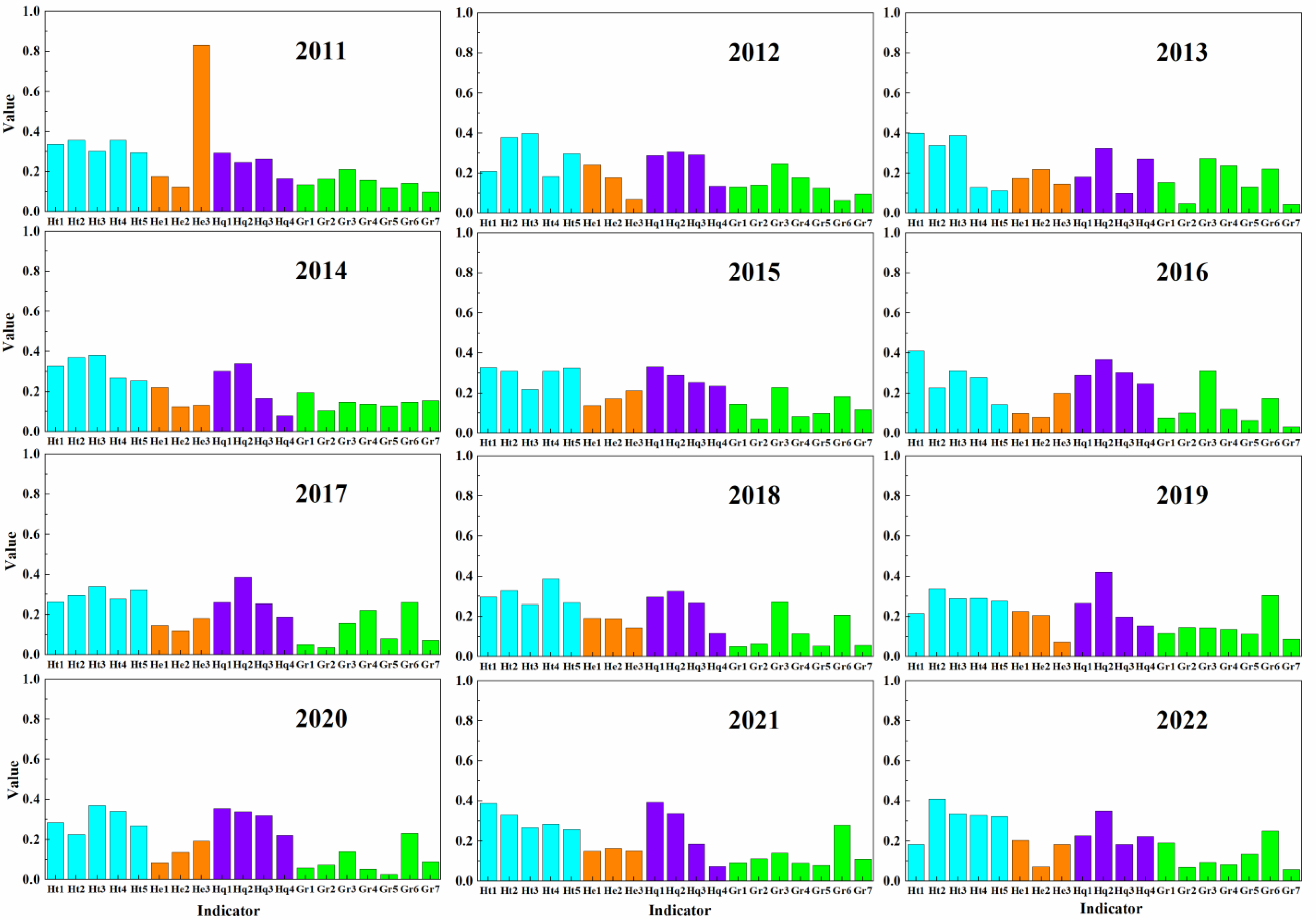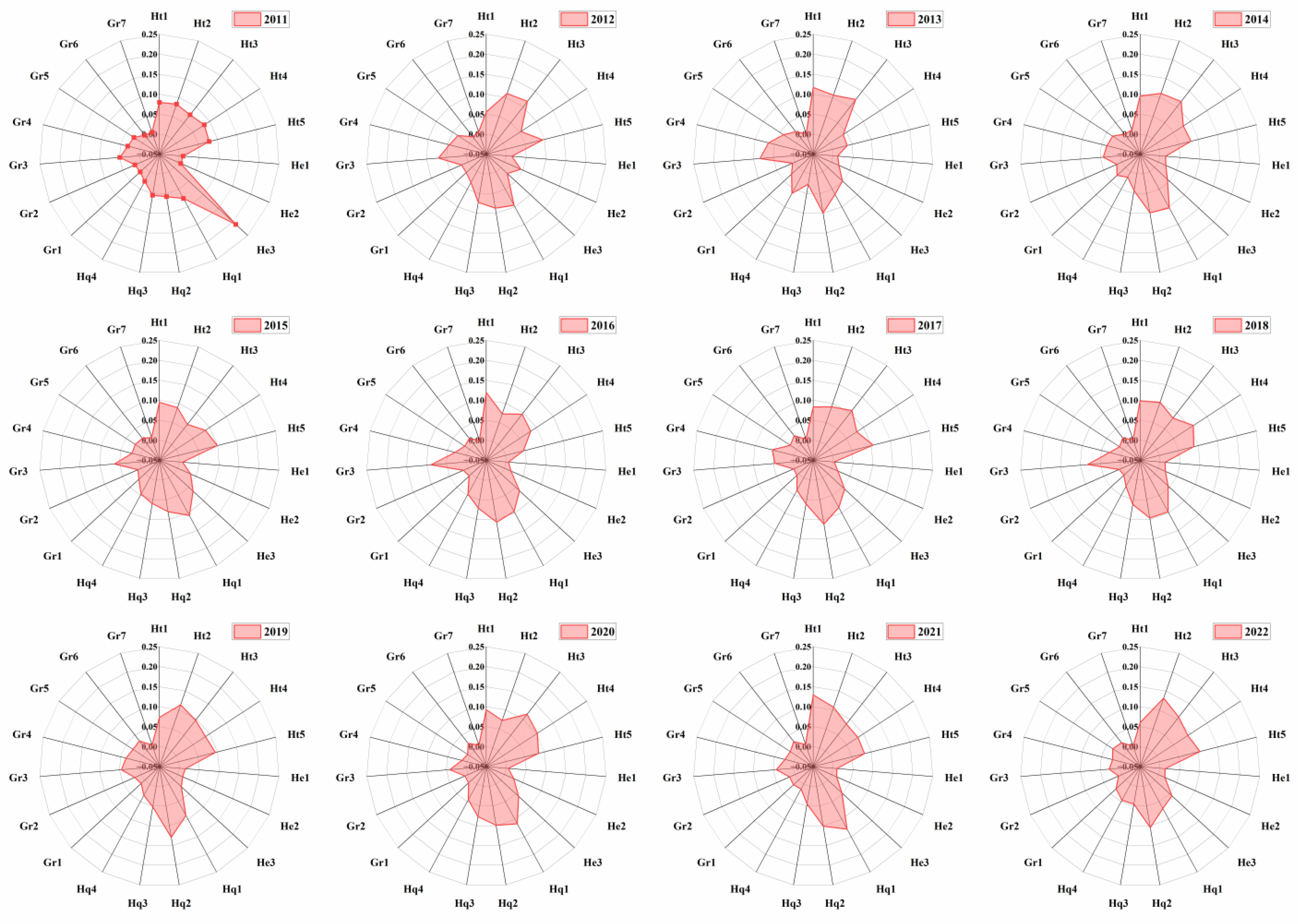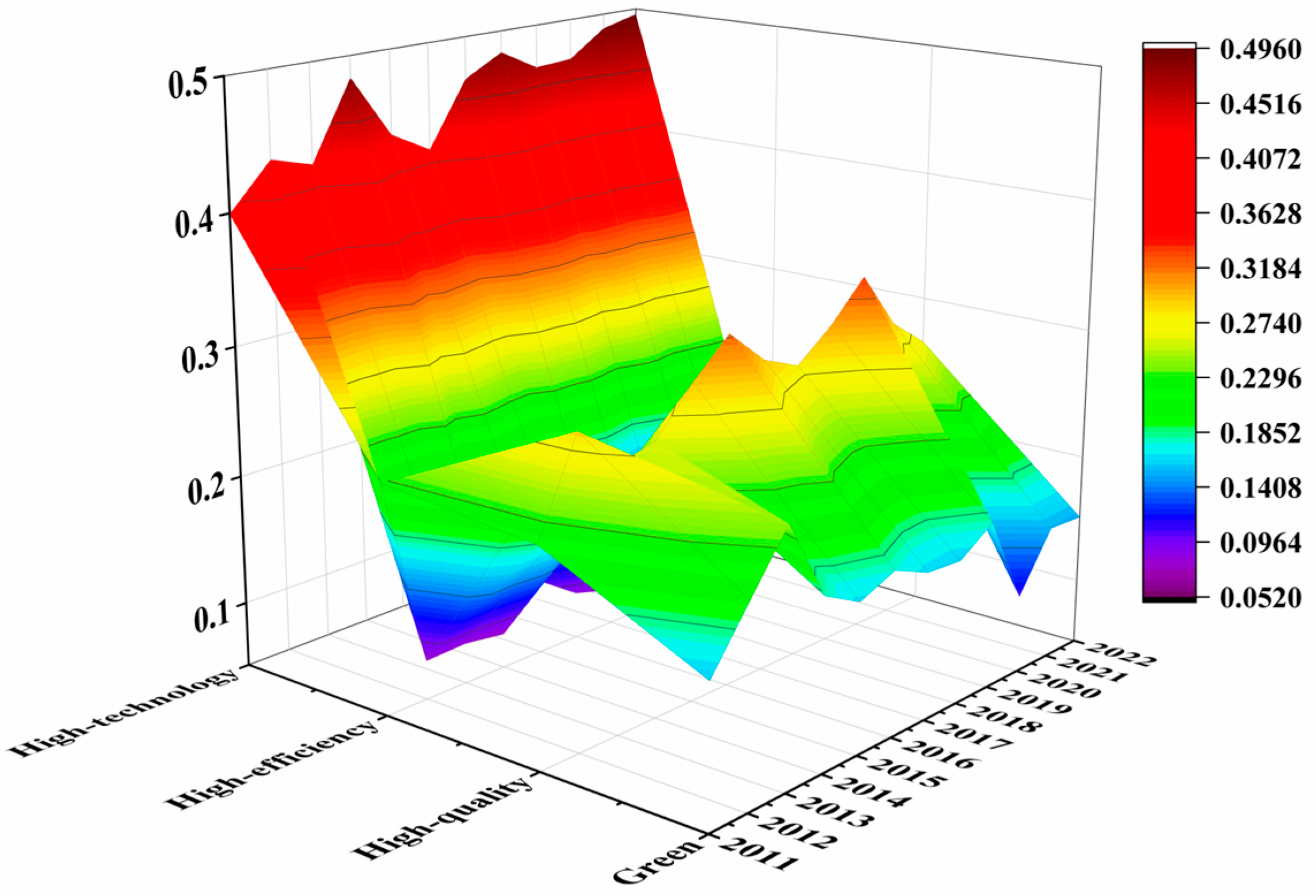Spatiotemporal Distribution and Obstacle Factors of New-Quality Productivity in Water Conservancy in China Based on RAGA-PP and Obstacle Degree Model
Abstract
1. Introduction
2. Materials and Methods
2.1. Study Area and Data Sources
2.2. Methods
2.2.1. Evaluation Indicator System for NQPWC
2.2.2. Real-Coded Accelerated Genetic Algorithm for Projection Pursuit (RAGA-PP)
2.2.3. Obstacle Degree Model (ODM)
3. Results and Discussion
3.1. Indicator Projection Directions for NQPWC
3.2. Diagnosis of Obstacle Factors in Development of NQPWC
3.3. Analysis of Effects of NQPWC
3.4. Analysis of Obstacles in Development of NQPWC
4. Conclusions and Prospects
4.1. Conclusions
4.2. Prospects
Author Contributions
Funding
Institutional Review Board Statement
Informed Consent Statement
Data Availability Statement
Conflicts of Interest
References
- Schmitt, T.; Bejarano, R.; Assuad, C. Challenges and opportunities of automated data pipelines for environmental sustainability applications in industrial manufacturing. Procedia CIRP 2024, 122, 623–628. [Google Scholar] [CrossRef]
- Rosário, A.T.; Dias, J.C. How has data-driven marketing evolved: Challenges and opportunities with emerging technologies. Int. J. Inf. Manag. Data Insights 2023, 3, 100203. [Google Scholar] [CrossRef]
- Hassan, S.T.; Wang, P.; Khan, I.; Zhu, B. The impact of economic complexity, technology advancements, and nuclear energy consumption on the ecological footprint of the USA: Towards circular economy initiatives. Gondwana Res. 2023, 113, 237–246. [Google Scholar] [CrossRef]
- Kihombo, S.; Ahmed, Z.; Chen, S.; Adebayo, T.S.; Kirikkaleli, D. Linking financial development, economic growth, and ecological footprint: What is the role of technological innovation? Environ. Sci. Pollut. Res. 2021, 28, 61235–61245. [Google Scholar] [CrossRef] [PubMed]
- Ahmad, M.; Jiang, P.; Majeed, A.; Umar, M.; Khan, Z.; Muhammad, S. The dynamic impact of natural resources, technological innovations and economic growth on ecological footprint: An advanced panel data estimation. Resour. Policy 2020, 69, 101817. [Google Scholar] [CrossRef]
- Pu, Q.; Huang, Y. Generation logic, theoretical innovation and time value of general secretary Xi Jinping’s important exposition on new quality productivity. J. Southwest Univ. Soc. Sci. Ed. 2023, 49, 1–11. [Google Scholar]
- Fagerberg, J. Technological progress, structural change and productivity growth: A comparative study. Innovation, Economic Development and Policy. Struct. Change Econ. Dyn. 2000, 11, 393–411. [Google Scholar] [CrossRef]
- Bustos, P.; Bruno, C.; Jacopo, P. Agricultural productivity and structural transformation: Evidence from Brazil. Am. Econ. Rev. 2016, 106, 1320–1365. [Google Scholar] [CrossRef]
- Zhu, D.; Ye, L. Agricultural new quality productive force in China: Level measurement and dynamic evolution. Stat. Decis. 2024, 40, 24–30. [Google Scholar]
- Song, H.; Zhang, X. Enabling New Quality Productivity Through Digital Transformation: Mechanisms, Challenges and path selection. J. Beijing Inst. Technol. Soc. Sci. Ed. 2024, 26, 41–51. [Google Scholar]
- Wu, F.; Song, Y.; Huang, R. Construction of evaluation index system of new quality productive forces of water conservancy under new development concept. Water Resour. Prot. 2025, 41, 85–91. [Google Scholar]
- Zuo, Q. National multi-level guarantee system for the water ecological health. J. Water Conserv. Eng. 2021, 52, 1347–1354. [Google Scholar]
- Chen, J.; Wang, Y.; Zhang, X. Study on the strategy of water supply security in the Yangtze River Economic Belt. J. Water Conserv. Eng. 2021, 52, 1369–1378. [Google Scholar]
- Giannetti, B.; Agostinho, F.; Eras, J.; Yang, Z.; Almeida, C. Cleaner production for achieving the sustainable development goals. J. Clean. Prod. 2020, 271, 122127. [Google Scholar] [CrossRef]
- Núñez-López, J.; Rubio-Castro, E.; Ponce-Ortega, J.M. Optimizing resilience at water-energy-food nexus. Comput. Chem. Eng. 2022, 160, 107710. [Google Scholar] [CrossRef]
- Wang, H.; Liu, Y.; Zhang, L. Implementation path of green development and high-quality development of watershed eco-cities under carbon peaking and carbon neutrality goals. Water Resour. Prot. 2024, 40, 16–24. [Google Scholar]
- Wu, Z. New quality productive forces empower Chinese path to modernization: Theoretical logic, dynamic mechanism and future path. Soc. Sci. Xinjiang 2024, 2, 20–28+148. [Google Scholar]
- Tang, H. Logical mechanism and key path of developing new quality productive forces to enhance capability of safeguarding water security. China Water Resour. 2024, 8, 1–5. [Google Scholar]
- Peng, J. Developing new quality productive forces by sci-tech innovation of water conservancy. China Water Resour. 2024, 6, 1–5. [Google Scholar]
- Liu, Y.; He, Z. Synergistic industrial agglomeration, new quality productive forces and high-quality development of the manufacturing industry. Int. Rev. Econ. Financ. 2024, 94, 10337. [Google Scholar] [CrossRef]
- Zuo, Q.; Qin, X.; Ma, J. Understanding of new quality productive forces of water conservancy and thoughts on its development. China Water Resour. 2024, 6, 21–25. [Google Scholar]
- Liu, J.; Min, J.; Wang, H. The dynamic evolution of new quality productive forces level and diagnosis of obstacle factors in the Yellow River Basin. Yellow River 2024, 46, 1–7+14. [Google Scholar]
- Bickel, P.J.; Kur, G.; Nadler, B. Projection pursuit in high dimensions. Proc. Natl. Acad. Sci. USA 2018, 115, 9151–9156. [Google Scholar] [CrossRef] [PubMed]
- Huang, P.; Ding, T.; Luo, Q.; Hou, D.; Yu, J.; Zhang, G. Defect localisation and quantitative identification in multi-layer conductive structures based on projection pursuit algorithm. Nondestruct. Test. Eval. 2019, 34, 70–86. [Google Scholar] [CrossRef]
- Ouyang, X.; Wang, J.; Chen, X.; Ye, H.; Watson, A.E.; Wang, S. Applying a projection pursuit model for evaluation of ecological quality in Jiangxi Province, China. Ecol. Indic. 2021, 133, 108414. [Google Scholar] [CrossRef]
- Gong, J.; Jiang, C.; Tang, X.; Zheng, Z.; Yang, L. Optimization of mixture proportions in ternary low-heat Portland cement-based cementitious systems with mortar blends based on projection pursuit regression. Constr. Build. Mater. 2020, 238, 117666. [Google Scholar] [CrossRef]
- Chen, Q.; Zhong, D.; Zhang, Y.H.; Liu, Z.; Pu, Y.; Zhang, L. Research on artificial intelligence based on projection pursuit and real coded genetic algorithm. In Proceedings of the 2023 4th International Seminar on Artificial Intelligence, Networking and Information Technology (AINIT), Nanjing, China, 21 August 2023; pp. 575–578. [Google Scholar]
- Liu, F.; Yang, L.; Xiao, S.; Zhang, D. Application of RAGA based on SA in calculating critical water depth of open channel. In Proceedings of the 2010 Sixth International Conference on Natural Computation, Yantai, China, 23 September 2010; pp. 2296–2300. [Google Scholar]
- Wang, L.; Wan, J.; Gao, X. Toward the health measure for open source software ecosystem via projection pursuit and real-coded accelerated genetic. IEEE Access 2019, 7, 87396–87409. [Google Scholar] [CrossRef]
- Niu, H.; Liu, Z. Measurement on carbon lock-in of China based on RAGA-PP model. Carbon Manag. 2021, 12, 451–463. [Google Scholar] [CrossRef]
- Yu, F.; Pei, L. The application of RAGA-PP model in environmental accounting information disclosure of enterprises in heavy pollution industries. Results Eng. 2024, 21, 101663. [Google Scholar] [CrossRef]
- Sigalla, O.Z.; Tumbo, M.; Joseph, J. Multi-stakeholder platform in water resources management: A critical analysis of stakeholders’ participation for sustainable water resources. Sustainability 2021, 13, 9260. [Google Scholar] [CrossRef]
- Li, Q.; Shan, W.; Yu, T.; Wang, T. Mathematical Methodology in the Seismic Resilience Evaluation of the Water Supply System. Appl. Math. Nonlinear Sci. 2022, 8, 45–54. [Google Scholar]
- Ahmad, I.; Waseem, M.; Lei, H.; Yang, H.; Yang, D. Harmonious level indexing for ascertaining human-water relationships. Environ. Earth Sci. 2018, 77, 1–9. [Google Scholar] [CrossRef]
- Zuo, Q.; Qin, X.; Ma, J. New quality productivity of water conservancy: Connotation interpretation, theoretical framework and implementation path. J. North China Univ. Water Resour. Electr. Power Nat. Sci. Ed. 2024, 45, 1–8. [Google Scholar]
- Wang, Q.; Zhan, L. Assessing the sustainability of the shale gas industry by combining DPSIRM model and RAGA-PP techniques: An empirical analysis of Sichuan and Chongqing, China. Energy 2019, 176, 353–364. [Google Scholar] [CrossRef]
- Yang, J.; Mao, Y.; Ma, Y.Q.; Wu, W.; Bai, Y. Integrated RAGA-PP water demand forecast model (case study: Shaanxi Province, China). Water Supply 2021, 21, 1806–1816. [Google Scholar] [CrossRef]
- Shi, Y.; Yang, S.; Chen, W.; Fan, Y.; Lu, L. Evaluation of development level of new quality productivity of water conservancy in China and analysis of its spatial and temporal evolution and driving factors. Water Resour. Prot. 2024, 40, 122–138. [Google Scholar]
- Ma, H.; Xiang, H.; Pang, Q. The impact of new quality productivity development on water resource utilization efficiency in China. Resour. Sci. 2025, 47, 485–500. [Google Scholar]
- Jing, X.; Tian, G.; Cheng, F. Logical mechanism and collaborative path of patient capital promoting development of new quality productive forces of water conservancy. Water Resour. Prot. 2025, 41, 99–106. [Google Scholar]







| Objective Layer | Criteria Layer | Indicator Layer | Unit | Attribute |
|---|---|---|---|---|
| NQPWC | High-technology(Ht) | Situation of Water Conservancy Research and Development Institutions—Expenditure (Ht1) | 104 CNY | + |
| New Product Development and Sales—Number of Development Projects (Ht2) | Item | + | ||
| Patents of Water Conservancy Industrial Enterprises (Ht3) | Project | + | ||
| Acquisition and Technological Transformation of Water Conservancy Technology (Ht4) | 104 CNY | + | ||
| Introduction of Foreign Water Conservancy Technology (Ht5) | Item | − | ||
| High-efficiency(He) | Water Consumption per CNY 104 of GDP (He1) | m3/104 CNY | − | |
| Water Consumption per CNY 104 of Industrial Value Added (He2) | m3/104 CNY | − | ||
| Per Capita Water Consumption (He3) | L/d | + | ||
| High-quality(Hq) | Number of Enterprises (Hq1) | Piece | + | |
| Enterprise Expenditure (Hq2) | 104 CNY | + | ||
| Personnel in Higher Education Institutions (Hq3) | Person | + | ||
| State of Science Popularization (Hq4) | Person | + | ||
| Green(Gr) | Chemical Oxygen Demand (Gr1) | Ton | − | |
| Ammonia Nitrogen Emissions (Gr2) | Ton | − | ||
| Area of Flood Prevention (Gr3) | 103 ha | + | ||
| Area of Soil Erosion (Gr4) | 103 ha | + | ||
| Afforestation Status (Gr5) | 103 ha | + | ||
| Total Generation of General Industrial Solid Waste (Gr6) | 104 tons | − | ||
| Total Industrial Wastewater Discharge (Gr7) | 104 tons | − |
Disclaimer/Publisher’s Note: The statements, opinions and data contained in all publications are solely those of the individual author(s) and contributor(s) and not of MDPI and/or the editor(s). MDPI and/or the editor(s) disclaim responsibility for any injury to people or property resulting from any ideas, methods, instructions or products referred to in the content. |
© 2025 by the authors. Licensee MDPI, Basel, Switzerland. This article is an open access article distributed under the terms and conditions of the Creative Commons Attribution (CC BY) license (https://creativecommons.org/licenses/by/4.0/).
Share and Cite
Wang, W.; Li, A.; Li, Y.; Zhou, X.; Yang, Y. Spatiotemporal Distribution and Obstacle Factors of New-Quality Productivity in Water Conservancy in China Based on RAGA-PP and Obstacle Degree Model. Sustainability 2025, 17, 4534. https://doi.org/10.3390/su17104534
Wang W, Li A, Li Y, Zhou X, Yang Y. Spatiotemporal Distribution and Obstacle Factors of New-Quality Productivity in Water Conservancy in China Based on RAGA-PP and Obstacle Degree Model. Sustainability. 2025; 17(10):4534. https://doi.org/10.3390/su17104534
Chicago/Turabian StyleWang, Wei, Aihua Li, Yiyang Li, Xiaoxiao Zhou, and Yafeng Yang. 2025. "Spatiotemporal Distribution and Obstacle Factors of New-Quality Productivity in Water Conservancy in China Based on RAGA-PP and Obstacle Degree Model" Sustainability 17, no. 10: 4534. https://doi.org/10.3390/su17104534
APA StyleWang, W., Li, A., Li, Y., Zhou, X., & Yang, Y. (2025). Spatiotemporal Distribution and Obstacle Factors of New-Quality Productivity in Water Conservancy in China Based on RAGA-PP and Obstacle Degree Model. Sustainability, 17(10), 4534. https://doi.org/10.3390/su17104534









